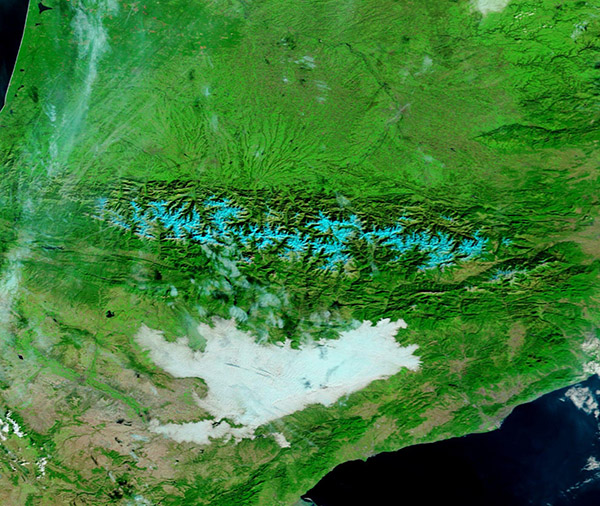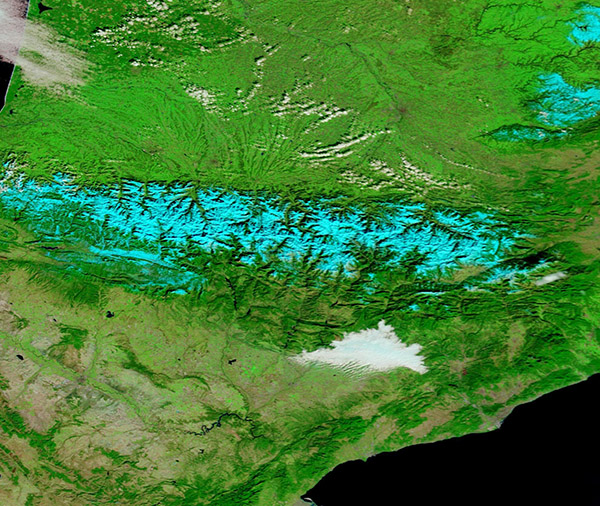Images
February 12, 2024 - Low Snow in the Pyrenees
Tweet
After a warm January across both Spain and France, mountain snow was sparse across the Pyrenees. Temperatures stayed above 0°C (32°F) for much of the month across Europe, even in the highest mountain altitudes. In fact, this was the warmest January on record globally, the Copernicus Climate Change Service (CCS) confirmed in a recent report. In France, local media reported a high temperature of 24.6°C (76.3°F) was recorded in the Ariège department, at more than 1,000 meters (3,280 feet) above sea level, 5°C (9°F) higher than any previous January recording.
The warm trend continued through February, shrinking snowpack across the Pyrenees even further. On February 10, Euronews.travel reported that an estimated 24 percent of ski resorts across Europe were closed due to higher-than-average temperatures and that the French Pyrenees were especially hard hit. The lack of snow forced cancellation of La Transjurassienne, the biggest cross-country ski race in France, which was due to be held on February 11. It has been held annually in the Jura Mountains since 1979.
The lack of snowpack in the Pyrenees has long ranging and complex effects across the region. These include a lack of tourism dollars that fuel the winter economy in the ski-loving communities, concern for drought due to the lack of precipitation, and significant risk of lack of snow melt to fill streams, rivers, and reservoirs that are so necessary for drinking water, agriculture, and summer recreation.
The Moderate Resolution Imaging Spectroradiometer (MODIS) on NASA’s Terra satellite acquired a pair of false-color images that illustrate the difference in snow cover between February 7, 2024 (top image) and February 2, 2023. Each image can be viewed by clicking on the date.
In this type of false-color image, snow appears electric blue and vegetation looks green. In addition, water appears dark blue or black while cloud-including low cloud (fog)-looks white. When comparing the images, it is clear that the amount of vegetation and water in various lakes are similar between the years. And a bank of fog is present in each image. What is starkly different is the substantial difference in snow – there is extraordinarily little visible in 2024 compared to 2023.
Image Facts
Satellite:
Terra
Date Acquired: 2/7/2024
Resolutions:
1km (137.7 KB), 500m (364.8 KB), 250m (509.7 KB)
Bands Used: 7,2,1
Image Credit:
MODIS Land Rapid Response Team, NASA GSFC
Tweet
After a warm January across both Spain and France, mountain snow was sparse across the Pyrenees. Temperatures stayed above 0°C (32°F) for much of the month across Europe, even in the highest mountain altitudes. In fact, this was the warmest January on record globally, the Copernicus Climate Change Service (CCS) confirmed in a recent report. In France, local media reported a high temperature of 24.6°C (76.3°F) was recorded in the Ariège department, at more than 1,000 meters (3,280 feet) above sea level, 5°C (9°F) higher than any previous January recording.
The warm trend continued through February, shrinking snowpack across the Pyrenees even further. On February 10, Euronews.travel reported that an estimated 24 percent of ski resorts across Europe were closed due to higher-than-average temperatures and that the French Pyrenees were especially hard hit. The lack of snow forced cancellation of La Transjurassienne, the biggest cross-country ski race in France, which was due to be held on February 11. It has been held annually in the Jura Mountains since 1979.
The lack of snowpack in the Pyrenees has long ranging and complex effects across the region. These include a lack of tourism dollars that fuel the winter economy in the ski-loving communities, concern for drought due to the lack of precipitation, and significant risk of lack of snow melt to fill streams, rivers, and reservoirs that are so necessary for drinking water, agriculture, and summer recreation.
The Moderate Resolution Imaging Spectroradiometer (MODIS) on NASA’s Terra satellite acquired a pair of false-color images that illustrate the difference in snow cover between February 7, 2024 (top image) and February 2, 2023. Each image can be viewed by clicking on the date.
In this type of false-color image, snow appears electric blue and vegetation looks green. In addition, water appears dark blue or black while cloud-including low cloud (fog)-looks white. When comparing the images, it is clear that the amount of vegetation and water in various lakes are similar between the years. And a bank of fog is present in each image. What is starkly different is the substantial difference in snow – there is extraordinarily little visible in 2024 compared to 2023.
Image Facts
Satellite:
Terra
Date Acquired: 2/7/2024
Resolutions:
1km (137.7 KB), 500m (364.8 KB), 250m (509.7 KB)
Bands Used: 7,2,1
Image Credit:
MODIS Land Rapid Response Team, NASA GSFC





